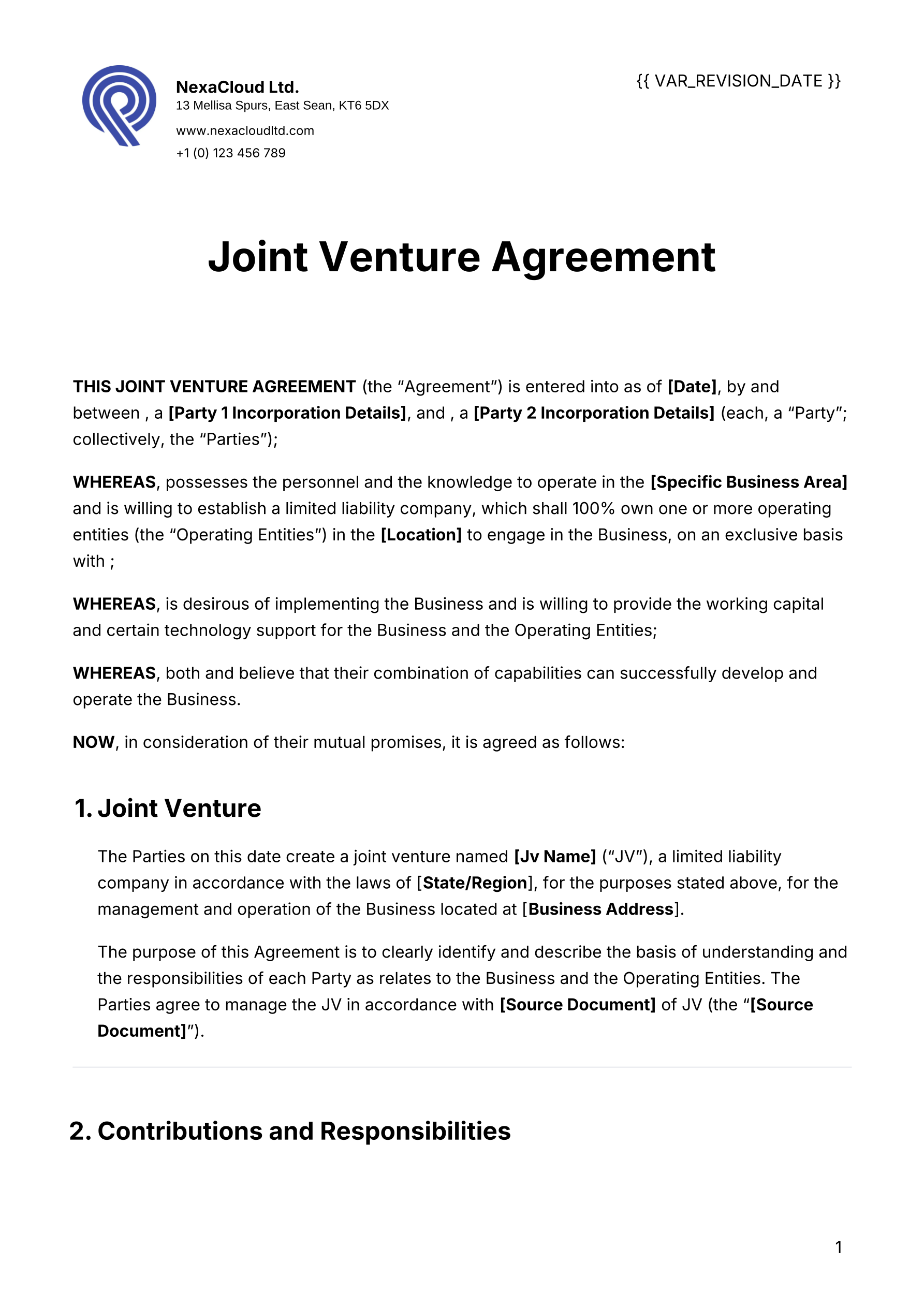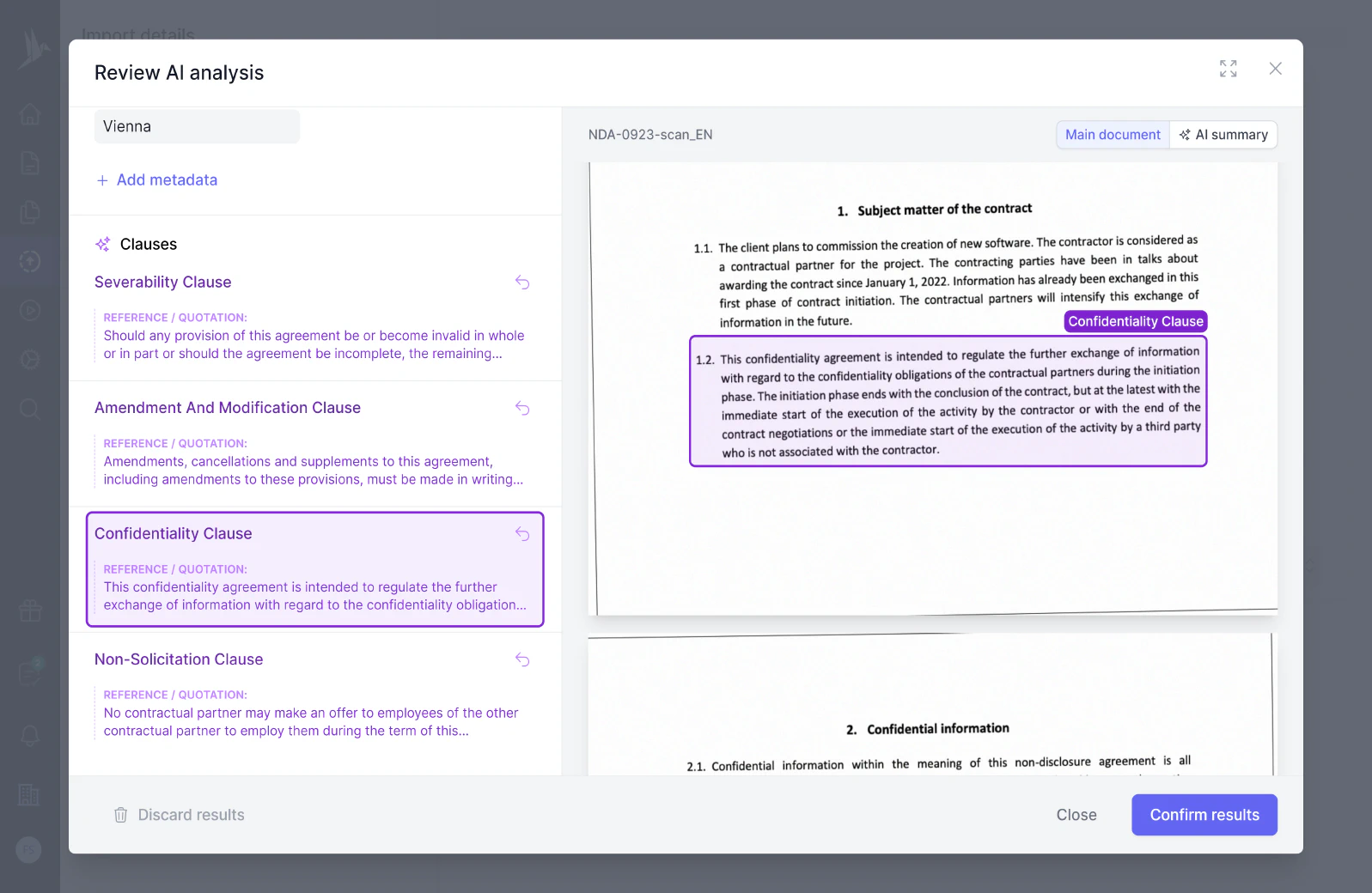
Equity-Based Joint Venture Agreement Template
A comprehensive and customizable joint venture agreement template designed to clearly define roles, contributions, management, and operational terms.
A "license back" clause grants the original owner of intellectual property some rights to use or exploit improvements made to that property by a licensee. This allows the licensor to benefit from enhancements or developments made by the licensee during the term of the license agreement.
Effect on Assignment and License Back. Retained Existing Contracts. Purple acknowledges that certain of the Incremental IP may currently be licensed to third parties under one or more agreements that are currently in effect and identified in the Assignment and License Back as “Existing Contracts” (such agreements, excluding the License Agreement, the “Retained Existing Contracts”), and that Purple’s right, title and interest in and to the Incremental IP and Purple’s ownership of any such Incremental IP is subject to the licenses granted in those Retained Existing Contracts.
License Back. To the extent necessary to enable EdiZONE to perform its obligations under the Retained Existing Contracts, and subject to all terms and conditions set forth in the Assignment and License Back, the Parties agree that the Incremental IP will be deemed included in the license back to EdiZONE as granted in the Assignment and License Back, but only as to the Retained Existing Contracts.
In the event Paranovus has acquired rights pursuant to Section 7.1 and 7.3 but has not completed its contemplated acquisition of Blueline by June 30, 2024 due to its own reasons: (a) Paranovus shall grant Blueline an irrevocable, perpetual, non-exclusive, royalty-free license (“License Back”) to use all Intellectual Property Rights in the Deliverable for the purpose of continuing to develop the Hollywood Sunshine game or for the purpose of developing any other project not directly competitive to the Hollywood Sunshine game; (b) in addition to the revenue share in Exhibit C, Paranovus’s revenue share in such derivative project resulting from 7.4(a) shall equal 76% of the Net Revenue after Celebrity Share multiplied by the quotient obtained by dividing the Development Fee paid by Paranovus by the total development cost invested in such derivative project; and (c) notwithstanding anything to the contrary contained herein, Blueline shall retain the right, but not the obligation, to pay Paranovus an amount mutually agreeable to both parties, and under terms mutually agreeable to both parties, in order to retain sole and exclusive ownership of all right, title and interest in and to all Deliverable, including all Intellectual Property Rights therein.
In addition, under the Joint Venture arrangements, the Company is entitled, in exchange for the payment of market-based fees under certain circumstances, to a license back from the Joint Venture of any improvements made to the RxNova™ platform during the course of the development project, and each of Anthem and Humana have the right, under certain circumstances, including any failure to successfully implement the PBM Platform in accordance with an agreed timeline and certain other factors, to exit the Joint Venture and receive, in connection with any such exit, a license to the PBM Platform.
Patent Assignment and License Back Agreement, dated May 2018, by and among Boris Goldstein, Dmitriy Prilutskiy, Stanislav Zabodaev, Memory MD, Inc. and (c) Medical Computer Systems Ltd. (Incorporated by Form 8-K filed on September 27, 2018)
The Company will receive a license back to the patents being sold and the transaction will not impact customers’ use of any of the Company’s products, solutions or services.
Retained Rights; License Back. The licenses granted to Foundational IP hereunder are subject to and contingent upon Company’s compliance with all of its obligations hereunder, including, but not limited to, the payment by Company to Flagship of all payments required under this Agreement, and further subject to rights hereby retained by Flagship and/or granted by Company to Flagship. Company hereby grants to Flagship a non-exclusive, royalty-free, fully paid, sublicensable (to Flagship Entities and service providers thereof) license to practice, and permit Flagship Entities to practice, the Foundational IP within the Licensed Field in the Territory solely to perform under the Managerial Agreement.
Back License. With respect to the patents included in Schedule 2.1(a) (the “Transferred IP”), Transferee hereby grants Transferor a perpetual, transferable, worldwide, royalty free, sub-licensable license to access and use the Transferred IP for the purpose of developing, marketing and sale of the Transferor’s Medigus Ultrasonic Surgical Endostapler (collectively, the “License Back”).
Present Assignment and License Back. It is intended by Borrower that this Assignment constitute a present, absolute assignment of the Leases, Rents, Lease Guaranties and Bankruptcy Claims, and not an assignment for additional security only. Nevertheless, subject to the terms of this Section 2.1 and the terms of the Loan Agreement and the Cash Management Agreement, Lender grants to Borrower a revocable license to collect, receive, use and enjoy the Rents, as well as any sums due under the Lease Guaranties. Borrower shall hold the Rents, as well as all sums received pursuant to any Lease Guaranty, or a portion thereof sufficient to discharge all current sums due on the Obligations, in trust for the benefit of Lender for use in the payment of such sums.
Personal License Back. During the term of this Agreement, Enochian will grant the Consultant the nonexclusive, royalty-free, personal right to assign to any of its members who are medical doctors the right to use the intellectual property controlled by Enochian relating to HIV treatment in humans solely to treat patients in the personal practice of medicine by such members (the “Right to Use”).
A “license back” is a legal agreement where one party grants certain rights to another party, while simultaneously receiving a license back to use certain aspects of the intellectual property originally licensed out. It is often used in business collaborations where both parties benefit from using each other’s technology or intellectual property. This mechanism ensures that the original owner retains some rights to use the licensed property, even while providing the licensee the ability to use it.
You should consider using a license back in situations where:
Writing a license back involves several critical components to ensure clarity and legality, including:
Example: If Company A licenses a patented technology to Company B, and Company B agrees to license back improvements and modifications to the original technology to Company A.
License back provisions can appear in various types of contracts, including:
Example: A pharmaceutical company licensing a drug formula to a biotech firm but receiving a license back for any newly discovered processes related to the drug.
These templates contain the clause you just read about.

A comprehensive and customizable joint venture agreement template designed to clearly define roles, contributions, management, and operational terms.
Dive deeper into the world of clauses and learn more about these other clauses that are used in real contracts.
A license fee clause outlines the payment terms and conditions under which a licensee is required to pay the licensor for the rights to use intellectual property, technology, or other licensed assets. It typically specifies the amount, frequency, and method of payment, and may also include adjustments based on usage, performance metrics, or renewals.
A license grant clause in a contract specifies the permissions and limitations under which the licensee can use the licensor's property, such as intellectual property or technology. It defines the scope, duration, territory, and conditions of the granted rights, thereby outlining the legal framework for usage and ensuring protection for the licensor's assets.
Licensed rights refer to the permissions granted by the owner of intellectual property or other proprietary assets to a licensee, allowing them to use, reproduce, or otherwise exploit those assets under specific terms and conditions. These clauses outline the scope, duration, and any restrictions or limitations associated with the granted rights, ensuring both parties have clear expectations regarding the authorized use of the licensed material.
Try our AI contract analysis and extract important clauses and information from existing contracts.
< <
Fill out the form and we will get in touch with you to give you a personal, customized demo of fynk.
Greetings!
I'm Markus, co-founder of fynk. After you've submitted the form, I'll swiftly get in touch with you.
Also, right after you submit your details, you can pick a time that works best for you for our meeting.

